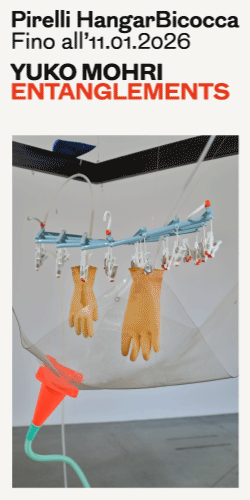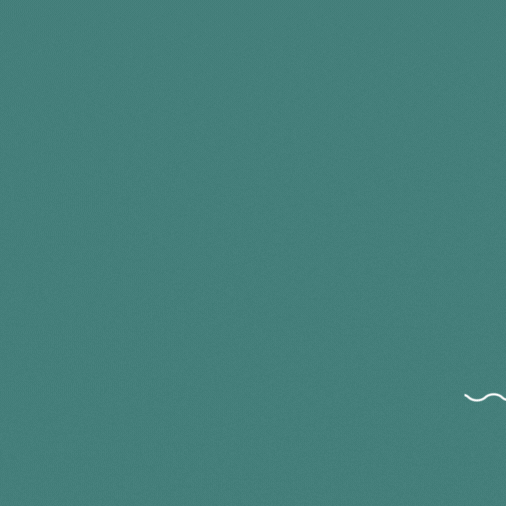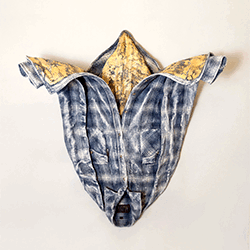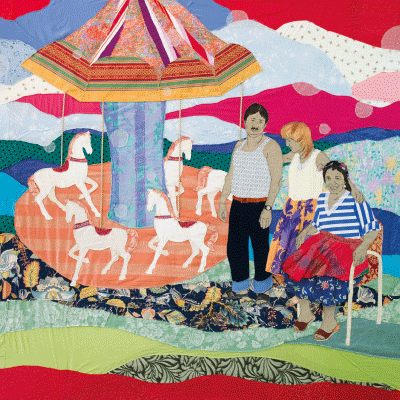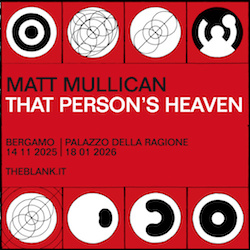
Segue il testo in italiano
Franco Noero’s Gallery presents Simon Starling’s fifth solo exhibition in Turin, hosted by the venue of via Mottalciata 10. With his new project – “Red, Green, Blu, Loom Music” – Starling takes us into an old factory of the 19th century, exploring a curious way of making images and noise through lights and looms, in a conversation between a piano and a 1930s computer. All these things start from Antica Fabbrica Passamanerie Massia Vittorio 1843, where the artist meets some old looms still working nowadays with punch cards invented by Jacquard in the late 17th century. While visiting the factory, he also discovers a piano with Rinaldo Bellucci’s “La Macchina Tessile” sheet music on it: Simon decides to play that music through a software that translates frequencies and decibels into coloured columns, and then again he obtains new punch cards from these pictures in order to let the looms produce wavings using RGB-colours threads.
A translation of sounds into colours and back, during the creation of textile material: all filmed and then presented with three video projectors interlacing light beams of the same three computer-colours. In the Gallery’s main room there is the piano now, playing Bellucci’s music automatically, thanks to the partnership with Rex Lawson who worked on the new punch cards.
Giovanna Repetto asked some questions to the artist.
ATP: So you just came back to Italy with a solo exhibition, and you did it in a particular city, Torino, that you know well: did you miss it or do you feel that it changed in the meanwhile? Does something look different in town?
Simon Starling: I have been coming to Turin for almost 20 years making exhibitions with Franco and Pierpaolo. Those exhibitions have always been very connected to the place: often working with local manifacturers or craftsmen trying to engage with the place in a literal way; and so, of course, you notice changes every time you come back; producers that you worked with to create something particular aren’t there anymore because they have gone out of business; well, also another aspect, like your engagement with the city, is flourishing, as there is a much larger interest in Turin, from outside, internationally. For example I just met the two curators that are running Museo Casa Mollino, Napoleone and Fulvio Ferrari: they just generated a kind of global interest in Carlo Mollino in the last 20 years, by a very systematic unfolding him as a character and as a designer, an architect and a photographer. Now Casa Mollino is a destination for architects from all around the world, for designers.. And so those kinds of people are changing the way Turin is perceived: Franco and Pierpaolo running the Gallery are also doing something similar, having a very international roster of artists.
ATP: Well, we can say that something changed for sure: I mean the gallery..From the previous site to this one, this is your first experience here; as often your works are site specific, when did you start conceiving this exhibition?
SS: One of the very nice things about working with the Gallery has been that, making five exhibitions, every one of them has been in a different space; that has always been a sort trigger, a starting point for thinking about the exhibitions because of the spaces that the Gallery occupied: they have always been very particular. The first space was very tiny, smaller than this office: it was nice because my work called “Flaga (1970-2000)”, a small car pinned to the wall of the gallery, perfectly fitted into that place giving it a kind of drama. And it was also a shop-front space so people would drive pass looking for parking places and they’d see my car parked on the wall of the gallery. Now it’s different, we are in bigger one, a clearly post-industrial building where other things have happened and things have been made: it’s so exciting for me. One of the inspirations for making this project was to fill again the gallery, and its the post industrial architecture, with the noises of production, like machines and manifacturers. And I think that those resonances between the work and the space are very important to make an exhibition functional and sharp”.
ATP: We know that “evolution” is something very important for your work and for all the research activities linked to it: does this exhibition come from another work in some way? Is it like an evolution of something previous?
SS: It does. The reason that I went with Franco and Pierpaolo to Massia was because Franco came across with this amazing factory and its old looms, a lot of them still running with punch cards, a technology developed by Jacquard. I made a work, about ten years ago, about the first computer produced by Conrad Zuse in Germany in 1930s: he decided to punch photographic film to program his computer: I was so fascinated by the relationship between the film, that carries an image, and the machine, so I made a small film installation work based on that. So Franco, when he saw this place, he immediately thought to me and my work: in that sense you could see this work as being an evolution, a next step, an investigation.
ATP: How was the experience in Passamanerie Massia?
SS: That place is incredibly captivating: even if it’s full of noise, the technicians running all the machines know if something is wrong by the sound of the same machines, as they are listening them although surrounded by a cacophony of sound; so it’s like a music changing, a bit hard to believe, but they can do it. As they look like characters with particular actions and idiosyncracies, this was inspirating in order to film them like in the middle of a conversation, a musical conversation between the different noises they make and the gestures they have. One of the exciting things is to go into a situation like that, and start to interrogate it, doing it along with the people who are working there: we also spent an evening, after the factory was closed, recording all of the individual noises the machines made; the chief technician helped us sticking a very sensitive microphone into tiny parts of the machines and then he wore the headphones to listen what it sounded like, spellbound by new noises. We can say that this work is a celebration of what they do, to sustain that craftsmanship.
ATP: Taking a picture of your exhibition in this moment… Could it be a starting point for a new work?
SS: Yes, sure, there is always a role one into the other: as the computer project became this project, there will be another evolution for this one as there are many aspects that I would like to continue to pursue. For the first time I am using video projectors, quite an old technology rather out of date, but the idea that you are filming a piece of weaving that is made with red, green and blue threads as the projector splits the light in the same colours, makes an nice connection between the subject and the means of display of the work. Maybe I will use it again in a different context.
ATP: As far as the loom for 19th century, car for 20th century and computer for nowadays, when did your connection with machines started? Is it something coming from your childhood or from your studies maybe?
SS: Well it’s a kind of interest in how things get made, and it goes back to my early age when I had a dark room because I wanted to be involved in making images: so I built a small dark room in a shed on the side of my parents’ house, I think I was eleven! Being very young, the results were a disaster in the beginning; anyway it was like miracolous to go into this little room, turn the red light on and watch these images appear somehow. My father was also a big diy-guy, he refused to let anybody else do anything in the house as he had to do it himself; so we had this really fantastic workshop, and I built things in it: I made a kind of acoustic guitar when I was still young, and a toboga, a sailing machines. I can say, yes, a fascination with making, which became a fascination with art and that was my way into it.
ATP: Finally, last question: which was the last exhibition that you saw?
SS: The last exhibition I saw? Well, it was..Yes, the last one was in London, an exhibition of Goya, “Portraits”, which I saw two weeks ago, around about Christmas time: it was amazing, horribly full of people, but a fantastic show”.

Simon Starling | Red, Green, Blue, Loom Music
20 gennaio – 5 marzo 2016
La Galleria Franco Noero presentare Red, Green, Blue, Loom Music, quinta personale di Simon Starling con la galleria e prima mostra concepita per gli spazi di via Mottalciata. Il nuovo progetto espositivo muove ancora una volta dal profondo interesse dell’artista per la ricchissima tradizione storica di manifattura, industria e design che caratterizza Torino. Questa volta tutto nasce dalla visita all’Antica Fabbrica Passamanerie Massia Vittorio 1843, un’azienda a conduzione familiare che ha sede nella vicina Pianezza, in un luminoso edificio del primo ‘900 un tempo fabbrica di Bakelite. L’azienda produce tessuti, galloni e cordoni di alta qualità utilizzando telai che risalgono fino al 1780. Molti dei telai sono ancora automatizzati e utilizzano le schede perforate, la rivoluzionaria tecnologia messa a punto da Joseph-Marie Jacquard alla fine del ‘700.
La straordinarietà del luogo ha immediatamente destato l’interesse che l’artista ha da lungo tempo per le tecnologie di creazione dell’immagine e, nel caso specifico, per la storia dell’elaborazione dei dati, fin dai suoi albori. L’argomento trova precedente sviluppo nel lavoro di Starling D1-Z1 (22, 686, 575:1), 2009, un’installazione e un film in 35 mm ispirati dallo Z1, il computer inventato da Conrad Zuse nel 1930 e programmato tramite pellicola 35 mm perforata. Il computer meccanico di Zuse fu costruito quasi un secolo dopo il viaggio del matematico e ingegnere britannico Charles Babbage a Torino, dove presento’ i progetti relativi alla costruzione di un computer ben più complesso – la Macchina Analitica – al Secondo Congresso degli Scienziati Italiani, al tempo chiamati ‘Filosofi’. Nel 1840, sulla via per Torino, Babbage si fermò alla Croix-Rousse a Lione per assistere alla produzione di un ritratto in seta tessuta di Joseph-Marie Jacquard (1752-1834) che richiedeva l’impiego di ben 24.000 schede perforate, sistema messo a punto dall’inventore francese. La cosiddetta “incisione in seta” fu in seguito presentata da Babbage a Carlo Alberto, Re di Sardegna e del Piemonte, come regalo per sua moglie la Regina Maria Teresa, ed è tuttora conservata nelle collezioni di Palazzo Reale.
L’interesse di Starling per l’Antica Fabbrica si è ulteriormente acuito quando ha notato uno spartito manoscritto poggiato sul leggio di un pianoforte a coda, del tutto inaspettatamente collocato nell’ufficio di rappresentanza dell’azienda: composta da Rinaldo Bellucci, La Macchina Tessile è una creazione musicale ispirata alle incantevoli macchine presenti nella Fabbrica. La composizione musicale è stata quindi suonata e registrata: si è potuto quindi trarne una sorta di “spartito visivo” tramite un software di visualizzazione del suono, il quale trasforma la musica in semplici bande di colore a seconda della frequenza (Hz) e dell’intensità (dB) delle note. La musica dello spartito, trasformata in un’immagine a colori dal computer, ha potuto essere riformulata in una catena di schede perforate Jacquard in cartone, sulle quali sono riportati i “dati” necessari ai telai per produrre un tessuto dalla trama di fili rossi, verdi e blu, che è l’effettiva traduzione tessile dello ‘spartito visivo’.
Il processo di traduzione della composizione musicale in tessuto è divenuto il soggetto di un film girato dall’artista in cui i telai sono protagonisti, personaggi chiave nello svolgersi di quella che può definirsi una sceneggiatura ‘automatizzata’. In galleria il cortometraggio girato da Starling viene proiettato da una particolare macchina a 3 tubi che emette luce rossa, verde e blu, producendo un’immagine a colori che replica il processo di tessitura ripreso nel film ed evoca la nascita della fotografia a colori, il cui primo esempio fu ‘messo in scena’ nel 1861 – al cospetto di un pubblico rapito – utilizzando 3 lanterne magiche con filtri rossi, verdi e blu per raffigurare un ritaglio di tessuto tartan.
Grazie alla collaborazione con Rex Lawson, esperto concertista e appassionato conoscitore di uno strumento musicale quale la pianola, o pianoforte meccanico, un esemplare Weber ‘Duo-Art’ del 1920 è stato adattato per l’accompagnamento sonoro di una sezione del film. La composizione musicale ‘trovata’ nella Fabbrica, incisa su un rotolo di carta da pianola analogamente alle schede perforate, viene eseguita a intervalli fissi dallo strumento meccanico privo di esecutore, in modo che l’affezionata ode ai telai composta da Rinaldo Bellucci, interpretazione pulsante del loro suono affascinante, faccia vibrare le sue note all’interno degli spazi post industriali della galleria.
Insieme al film e al suono della pianola che l’accompagna, ‘eseguiti’ nello spazio principale, Starling presenta altri due lavori correlati. Il primo prende le forme di 4 traduzioni, o manifestazioni equivalenti, del brano musicale di Bellucci: uno spartito manoscritto, le schede perforate utilizzate, le bande di tessuto realizzate tramite esse e il rotolo di carta perforata da pianola con l’arrangiamento musicale di Rex Lawson. L’ultimo lavoro di Starling in mostra prende invece spunto dal viaggio a Torino via Lione di Charles Babbage nel 1840, quando il matematico presento’ le sue ricerche ‘proto-digitali’, ed è realizzato con una macchina che eredita e attualizza le teorie di Jacquard, un telaio ad alta tecnologia operato da un computer. L’immagine digitale di un passo di due pagine dell’autobiografia di Babbage, Passages from the Life of a Philosopher, ha permesso di produrre un facsimile a trama tessile con il quale ci si addentra nella lettura del resoconto lirico e a tratti comico dell’incontro tra Babbage e il Re Carlo Alberto, e del dono dell’ ‘incisione in seta’ del ritratto di Jacquard.





